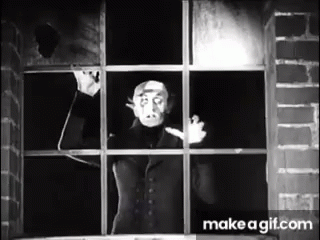The next dark step for vampires...

It's fitting that
Dracula becomes the last (and paradoxically, also first, at least first proper) vampire novel of the nineteenth century, as it marks a turning point in vampire, horror, gothic and even adventure literature, setting down standards and tropes, and introducing us to concepts which would characterise novels of its type right up to today.
Dracula can easily be seen as a demarcation line, showing where the idea of just writing a novel about a vampire, or a novel with a vampire, changed to become the process of writing a vampire novel. In other words, the point at which vampire novels rose out of the grip, as it were, of gothic fiction and became their own genre.
Nowhere would this be more evident than in vampire movies.
And so, after a deep exploration of the origins, and rise within early literature of vampires, we come to the next stage. Although vampires are as popular today in books as they ever were, and have gone on to star or feature in comics too, the beginning of the twentieth century would herald a new age, and provide for the humble literary vampire a bridge to a new world, as they took their first faltering, and indeed silent and monochrome, steps onto the silver screen. Once vampires were seen on film, their popularity soared and they would become inextricable from the public consciousness. Those who did not care for books, had no time for them or, perhaps in some cases, certainly at the turn of the century, could not read, were able to experience the full drama, mythos and horror of the creature who had frozen the blood and quickened the heartbeat of all who had read about him.
For a long time, as you might expect, vampires remained exclusively male. Despite the power of Le Fanu's quasi-lesbian anti-heroine Carmilla, it was either decided having female vampires on the screen was too much of a leap for the audience, or was considered immoral to portray women in such an evil and lustful way. It would take time - mostly due, I think (though I will research and we'll explore it in depth once the time arrives) to Hammer Pictures, who would break many cinematic taboos in their time - before women would take their place alongside their male counterparts in evil. But for now, the only roles available for them would be that of the victim, screaming (soundlessly, for some time) and imploring someone, anyone to rescue them.
Of course, in time vampires would transition to the small screen, where they would become even more popular and famous, and, some might argue, quite watered down as the writers of various televisions series strove to de-monstrify, if you will, the creature of the night and explore what made him tick, and how he - or she - might survive, even thrive in the new century they found themselves in.
But most people would come to know vampires under the name all but copyrighted by Bram Stoker, and for many decades Dracula would reign supreme as the only vampire in town. But he wasn't the first, and in time he would be supplanted by, ironically, younger (at least looking), hipper vampires more in tune with the modern world, and would find himself, in a sort of closing of the circle, again out of touch, pushed to the background, all but forgotten, occasionally dragged screaming out into the daylight to suffer yet another reinvention, reinterpretation or even rebirth, as writer after writer put their own spin on Stoker's unique creation.
So in part two I will of course be continuing to track this remorseless killer through the pages of the novels he, and she, stalked, but I will be concentrating more on the movies, as this is when the vampire really came of age. You could call the onset of movies – from the black-and-white silent ones to the first ever talkies - almost the true birthplace of the vampire we know today, the silver screen the conduit through which the creation of Stoker and the writers before him came snarling into our collective human consciousness, and has never really left. A golden age, perhaps, or more accurately a dark age for the vampire, as he – and she – strode purposefully forward in this brave new world, determined to bend it to their will.
I'll again have to check, but I think it may be the case that the first true horror movie was also a vampire one, as other supernatural creatures, from ghosts to werewolves and mummies – and later zombies of course – only turn up much later in the history of cinema, so in many ways, if that's true, then the vampire was, as it were, in on the ground floor, or, to completely screw up the metaphor, at the very top of the horror food chain from the beginning. As he was destined to be the monarch of the macabre in literature, so too would he assume his throne as the apex predator of movie-goers' minds and stride with a sneer of contempt into their dreams and their nightmares, kicking off many an epiphany in the brains of writers of later vampire fiction.
If the literary vampire of the eighteenth and nineteenth century had, by and large, survived by cloaking himself in shadow and hiding from the world of light, the twentieth century equivalent would walk boldly out into that (metaphorical) light and declare his presence for all to see. You could almost hear in his hissing, sibilant, seductive voice the words of the pharaoh Ramesses II, as imagined by Shelley: “My name is Ozymandias, King of Kings. Look upon my works, ye mighty, and despair!”